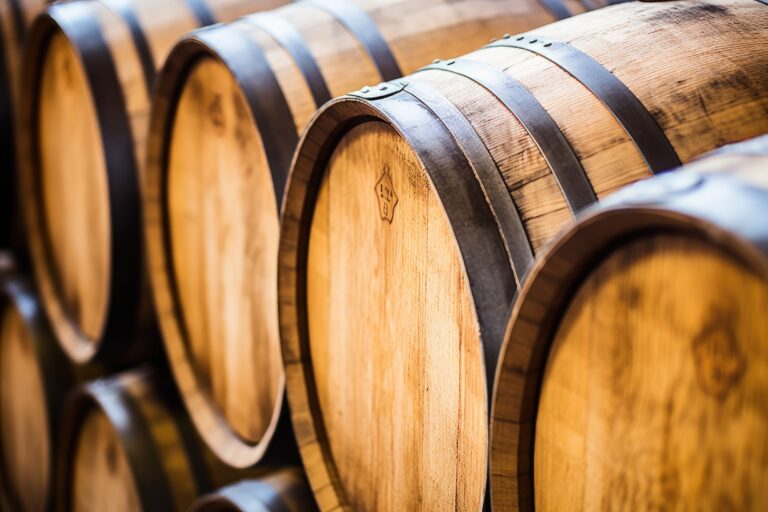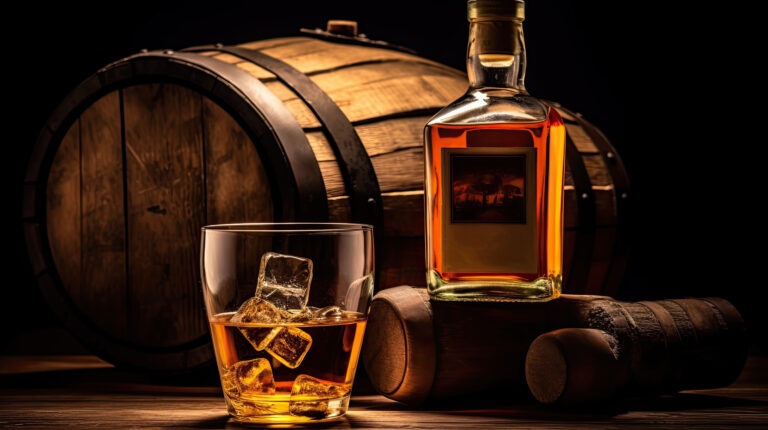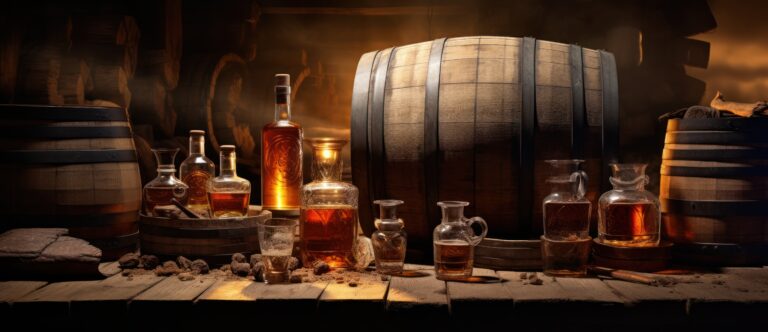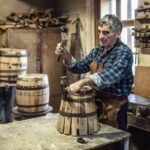Ever wonder how much whiskey can fit in one of those oak barrels? As a whiskey enthusiast, you’ve probably seen hundreds of barrels aging in warehouses and distilleries. But have you ever stopped to think about the actual size and capacity of a whiskey barrel? These handcrafted casks play an integral role in giving whiskey its characteristic color and flavor during the maturation process. In this quick guide, we’ll give you an overview of the standard dimensions and sizes of whiskey barrels so you can get a sense of just how much of the good stuff is aging and waiting to be bottled up.
Introduction to Whiskey Barrels
Whiskey barrels come in a variety of sizes, but the most common are the standard bourbon barrel and the hogshead.
- A standard bourbon barrel holds approximately 53 gallons or 200 liters of whiskey. It measures about 34 inches high and 24 inches in diameter. These barrels are made of American white oak.
- A hogshead barrel is slightly larger, holding around 66 gallons or 250 liters. It stands approximately 36 inches high with a diameter of 28 inches. Hogsheads are commonly used for aging Scotch whisky and are also made of oak.
Whether you’re aging whiskey or just looking to use an empty barrel as decor, it’s good to understand the dimensions so you know how much space it will take up. Barrels aren’t exactly compact! But their size is necessary to properly age spirits like whiskey, rum, and brandy.
The aging process gives the liquor more complex flavors through oxidation and extraction of flavor compounds from the wood. And the larger the barrel, the more surface area in contact with the wood and the faster the aging process.
So next time you’re enjoying an aged whiskey, rum or brandy, raise your glass to the humble oak barrel that made it all possible! Its generous size and wood composition are what turn raw distilled spirits into the amber elixirs we know and love.
Standard Whiskey Barrel Dimensions
A standard whiskey barrel has very specific dimensions that allow for optimal aging of the spirit.
Size
Most barrels used in whiskey production hold 53 gallons, giving them a diameter of about 31 inches and a height around 34 inches. Barrels of this size maximize the surface area to volume ratio, allowing for effective interaction between the whiskey and the wood.
Wood
These barrels are traditionally made of American white oak, which imparts desirable flavors to the whiskey as it ages like vanilla, caramel, and spice. The oak is usually sourced from forests in the Midwestern United States.
Char
The inside of the barrels are charred, which means they are exposed to an open flame that blackens the wood. The level of char impacts how much flavor the wood imparts to the whiskey. Heavy char provides more robust, smoky notes, while lighter char leads to subtler oak flavors.
Aging
The typical aging period for whiskey in barrels is at least 2 years for bourbon and 3 years for rye whiskey. However, many premium whiskeys age 4 years or more to achieve extra depth and complexity. The longer a whiskey ages in the barrel, the more it takes on the signature flavors and amber color we associate with aged spirits.
With the proper wood, char level, and aging time, these standard whiskey barrels transform distilled spirits into the rich, flavorful whiskeys we all know and love. Understanding the dimensions and construction of barrels provides insight into how whiskeys develop their distinctive flavors and aromas during maturation.
Factors Affecting Barrel Size
The size of a whiskey barrel depends on several factors.
Wood Type
The type of wood used, like oak, will determine how much liquid the barrel can hold. Oak is a popular choice because it’s porous and allows for flavor exchange.
Barrel Shape
The shape and curvature of the barrel also impacts its size. Barrels that are more round will hold more than barrels with a squared shape.
Barrel Age
Newer barrels that haven’t been used before tend to be larger since the wood hasn’t expanded yet. As barrels age, the wood swells which decreases the amount of whiskey that fits inside. Many distillers use barrels multiple times to maximize their investment.
Barrel Toasting and Charring
How much the inside of the barrel is toasted and charred during the manufacturing process will influence the barrel size. More toasting and charring produces more wood character but also decreases volume. Distillers have to find the right balance.
Regional Preferences
The typical barrel sizes used depends on the region and their traditional styles of whiskey. For example, bourbon barrels in the U.S. are usually larger while barrels in Scotland used for Scotch whisky tend to be smaller. Customers expect certain barrel sizes for different whiskey types.
In the end, a variety of interrelated factors like wood type, shape, age and treatment work together to determine a whiskey barrel’s dimensions. Distillers carefully consider all these elements to produce barrels perfectly sized for their needs.
How Barrel Size Impacts Whiskey Flavor
The size of a whiskey barrel directly impacts how the whiskey ages and develops flavor. Smaller barrels mean more surface area, so the whiskey has more contact with the wood. This results in faster aging and more pronounced wood flavors like vanilla, caramel and oak.
On the other hand, larger barrels produce whiskey with subtler wood notes since less of the liquid is in contact with the wood. The slower aging process allows more complex flavors to develop. Whiskey from larger barrels may have notes of dried fruit, nuts or spice.
Many distilleries experiment with different barrel sizes to produce unique and complex flavors in their whiskeys. Some even use a variety of barrel sizes and then blend the whiskeys together before bottling to create layered, balanced flavors.
The standard whiskey barrel size is 53 gallons, but you’ll find many craft distilleries using smaller barrels around 5 to 30 gallons for some of their releases. If you want to experience how barrel size impacts flavor firsthand, try tasting whiskeys aged in different sized casks from the same distillery. You’ll be amazed at the difference the humble barrel can make.
Typical Whiskey Barrel Shapes
There are a few standard shapes for whiskey barrels. The most common are:
- Round: The traditional barrel shape. Round barrels are ideal for aging whiskey as they have a large surface area to volume ratio, allowing for more interaction between the whiskey and the wood.
- Oval: Slightly more oblong than round barrels. Oval barrels are also very common and work well for aging whiskey.
- Squat: Shorter, more rounded barrels. Squat barrels have less air space at the top, which can accelerate aging. Some distillers use squat barrels to achieve a quicker flavor infusion from the wood.
No matter the shape, the standard size for a whiskey barrel is around 53 gallons or 200 liters. The specific proportions of a barrel impact the aging process and flavor of the whiskey. Master distillers carefully select barrels shapes and sizes to achieve their desired taste profile.
Calculating Volume of a Whiskey Barrel
To calculate the volume of a whiskey barrel, you’ll need to know a few measurements.
Circumference
Measure around the widest part of the barrel. For most whiskey barrels, this will be near the middle. Use a flexible tape measure to get the circumference in inches.
Diameter
Divide the circumference by 3.14 to get the diameter. The diameter is the width of the barrel opening and the widest part of the barrel.
Length
Measure from the top to the bottom of the barrel in inches. The length will determine how much whiskey the barrel can hold.
Volume formula
Use the formula: Volume = πr2h. π ≈ 3.14.
r = radius (diameter ÷ 2)
h = length (height)
So if your barrel is 24 inches in diameter and 36 inches high,
the radius is 12 inches (24 ÷ 2 = 12)
Volume = 3.14 x 122 x 36 = 4,522 cubic inches
Since there are 231 cubic inches in a gallon, 4,522 cubic inches ÷ 231 = about 19.6 gallons.
A typical whiskey barrel holds between 53 to 63 gallons. Smaller barrels age whiskey faster, while larger barrels produce mellower flavors. The most common whiskey barrel size is 53 gallons.
Knowing the volume of your whiskey barrel will help you determine how long to age your whiskey to achieve the desired result. The smaller the barrel, the less time needed. But no matter the size, patience is required – good whiskey can take years to develop!
Common Woods Used for Whiskey Barrels
The most common woods used for whiskey barrels are:
- Oak: The king of barrel woods. Oak barrels, specifically American white oak and French oak, are the most popular for aging whiskey. Oak adds flavor compounds like vanilla, coconut, and spice.
- Maple: Sometimes used for finishing barrels. Maple adds subtle sweetness.
- Ash: Rarely used, but adds hints of cocoa and smoke.
- Chestnut: Also rarely used, but imparts nutty, earthy flavors.
These woods are prized for the aromas and flavors they impart to the whiskey during aging. The natural compounds in the wood, like lignins, tannins, and vanillins, break down over time and leach into the spirit, creating its distinctive taste. The variety of wood, where it’s from, how it’s cut and dried, the barrel’s char level, and environmental factors like temperature all affect how much flavor is extracted during maturation.
After the barrel is built, it’s charred to different levels. Heavy charring, like alligator char, means more flavor will be imparted, while lighter charring produces subtler effects. The interaction between spirit and wood over time creates the smooth, complex flavor of aged whiskey. Choosing the right wood and char level allows distillers to craft a whiskey’s unique taste and aroma profile.
The Aging Process in a Whiskey Barrel
Once the whiskey has been distilled, it’s poured into charred oak barrels for aging and maturation. The aging process is vital to developing the flavor and aroma compounds that give each whiskey its distinctive character.
The Barrel’s Impact
The oak barrel has an enormous impact on the final flavor of the whiskey. As the spirit sits in the barrel, it absorbs compounds from the wood like vanillin along with the barrel’s charred layer. The longer it ages, the more complex the flavors become. Bourbon, for example, must be aged in new charred oak barrels to impart those familiar vanilla and spice notes.
Evaporation and Concentration
A small amount of the whiskey evaporates during aging, called the “angel’s share.” This concentration of the remaining liquid helps intensify the flavors. After several years, you’re left with a more robust, flavorful spirit.
Blending
Master distillers carefully monitor barrels during aging and then blend different barrels together to create the desired flavor profile for the final product. They know exactly which barrel will add hints of caramel or oak spice. Blending barrels aged for different lengths of time allows them to consistently produce the same taste that customers expect from their whiskey.
The aging process requires patience, but after several long years in the barrel, you’re rewarded with a smooth, complex whiskey that’s absorbed all the characteristics of the oak. And that makes the wait well worth it.
FAQ on Whiskey Barrel Dimensions
How big is a typical whiskey barrel? A standard whiskey barrel used for aging bourbon and Scotch is about 63 gallons or 238 liters in size.
How tall is a whiskey barrel? Whiskey barrels typically stand around 33 to 34 inches or 84 to 86 centimeters high. Barrels are made to standard dimensions so they can be stacked efficiently during the aging process.
What is the diameter of a whiskey barrel? Most whiskey barrels have a diameter of around 24 inches or 61 centimeters. This relatively small diameter, combined with the barrel’s round shape, provides the ideal surface area to volume ratio for the aging process.
Are all whiskey barrels the same size? While most distilleries use barrels of standard dimensions, some use custom sizes. For example, smaller 20 to 30 gallon barrels are often used by craft distilleries. Larger hogshead barrels of around 132 gallons are traditionally used for aging Scotch whiskies.
Do barrel sizes affect the flavor of the whiskey? Yes, smaller barrels generally impart flavor to the whiskey more quickly due to the increased surface area to volume ratio. Whiskeys aged in smaller barrels tend to be darker in color and have more pronounced oak flavors. Larger barrels are more subtle, producing lighter whiskeys with more complex, layered flavors.
In the end, while barrel dimensions are fairly standard across the whiskey industry, subtle differences in size and wood type can have a significant impact on the final flavor and aroma of an aged whiskey. The interaction between spirit and barrel is a fascinating alchemy that produces some of the world’s most prized elixirs.
Final Thoughts
So now you know the exact dimensions of a standard whiskey barrel. Pretty straightforward, right? Those oak barrels may seem simple, but they’re crucial for aging whiskey and imparting flavor. The specific size and shape, along with the wood type, all factor into the finished spirit in your glass. Next time you’re sipping a bourbon, scotch or rye, appreciate the humble barrel it came from. Though often overlooked, barrels deserve recognition for transforming raw distillate into complex, smooth aged whiskey. And if you’re ever lucky enough to visit a distillery, keep an eye out for those familiar barrels – they’re hard at work aging America’s native spirit.







